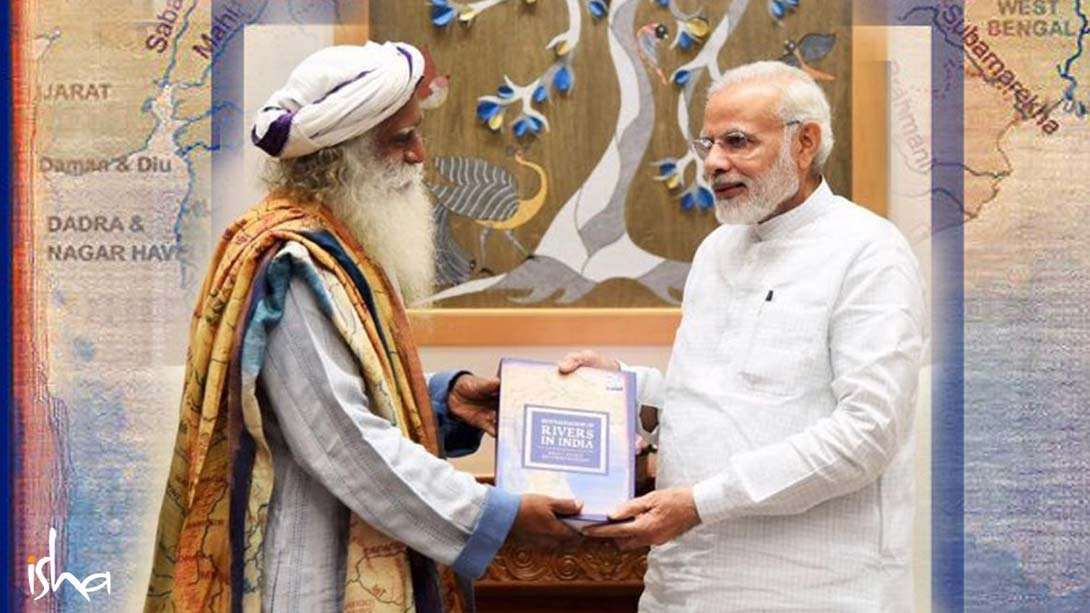Revitalization of Rivers in India – Towards a Holistic Policy Framework
In Part 2 of our excerpts from the Revitalization of Rivers in India Draft Policy Recommendation, we outline the severity and urgency of the problems facing India’s rivers and what can be gained by taking action to save them.

At the culmination of the month-long Rally for Rivers journey across the country, the Revitalization of Rivers in India Draft Policy Recommendation was presented to the government on October 3, 2017. Want to learn more about exactly how this multi-faceted approach will aid India’s rivers? We’ve provided a series of excerpts from the document for you to explore. In Part 2, we outline the severity and urgency of the problems facing India’s rivers and what can be gained by taking action to save them.
Part 1 | Part 3 | Part 4 | Part 5 | Part 6 | Part 7
Rivers have been the origins of the earliest human civilizations. They have etched their paths, cutting through rocky terrain to create fertile floodplains. Being home to a wide range of biodiversity, the rivers have assumed a distinct identity as ‘life givers’ across the world. What’s more, rivers in India have significance beyond economic wellbeing, as they are inextricably intertwined with our cultural and spiritual heritage.
Subscribe
In the past few decades, our rivers have been depleting drastically due to various factors like over-extraction, deforestation, pollution from point and non-point sources, and climate variation (increasing temperatures and differential precipitation patterns). Major rivers are rapidly shrinking, and many perennial rivers have turned seasonal, not even reaching the oceans for many months of the year. Godavari has shrunk by almost 20% from historical flows. Kaveri has shrunk by 40%, while Krishna and Narmada have shrunk by 60%. According to estimates, by 2030 we will have only 50% of the water that we need for our survival. Furthermore, 25% of India is becoming desert. As compared to 1947, we have about 25% water per capita available today. Rivers meet one-third of the total irrigation and 20% of the drinking water needs of the country. Groundwater and other water bodies/resources that meet the rest of our water needs are already over-stressed across the nation and are being over-utilized at an alarming rate. Twenty-two out of thirty-two major Indian cities deal with daily water shortages. Water scarcity and drought has become a reality for today’s generation in India. If priority action is not initiated to enhance water supply and reduce overexploitation of our water resources, then in another fifteen to twenty years’ time, the country may face a severe water and food crisis.
Recognizing this crisis, the Government has launched programs like Namami Gange and Namami Devi Narmada to improve the state of rivers. However, what are now needed are large-scale interventions that seek to protect and revitalize our riverine ecosystem. Given the state of affairs, a holistic policy framework is desirable, one which focuses on river revitalization that combines source augmentation and conservation of rivers. This needs to happen both at the national and state government levels.
Furthermore, such an effort to revitalize rivers needs to happen in conjunction with improving the livelihoods of riverine communities. This will ensure ownership and economic benefits for the community, leading to an effective protection and conservation of the river in the long run.
At the international level, India stands committed to the United Nations’ Sustainable Development Goals (SDG) 2030, which emphasize “leaving no one behind”. A holistic policy framework aimed at revitalizing our rivers and enhancing the livelihoods of riverside farmers and communities will also help India achieve SDG 6 (Clean Water and Sanitation), Goal 15 (Life on Land) and Goal 13 (Climate Action). It will also have an important impact on other SDGs – particularly Goal 1 (Poverty), Goal 2 (Zero Hunger), Goal 3 (Good Health and Wellbeing), Goal 8 (Decent Work and Economic Growth), Goal 9 (Industry, Innovation and Infrastructure), Goal 10 (Reduce Inequality), Goal 11 (Sustainable Cities and Communities) and Goal 12 (Sustainable Production and Consumption).
Rivers need to be recognized as a ‘national treasure’. The protection of rivers should encompass: a) ensuring full ecological/environmental flows; and b) preserving biological, chemical and physical characteristics of the water that protect the gene pool. Rivers need to be accorded due place in India’s development agenda, since they support a sizeable population directly and indirectly. Hence the demand to conserve and revitalize our rivers becomes paramount.
Editor’s Note: The above content is an extract from the Revitalization of Rivers in India Draft Policy Recommendation. If you are concerned about India’s rivers, the simplest way you can participate in revitalizing them is by giving a missed call to 80009 80009. Find out how a missed call will help in saving our rivers.
Gupta, Harish, Shuh-Ji Kao, and Minhan Dai. "The role of mega dams in reducing sediment fluxes: A case study of large Asian rivers." Journal of Hydrology 464 (2012): 447-458
Improving Water Security in India, India Policy Paper, OECD
A Quarter of India’s Land Is Turning into Desert, Scientific American




